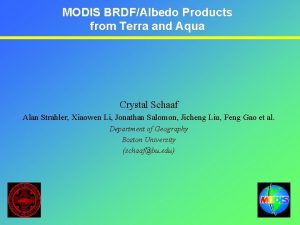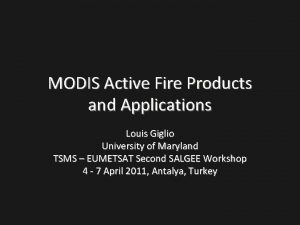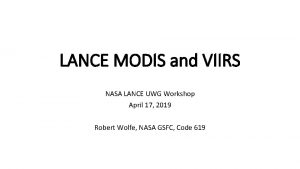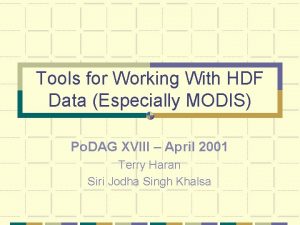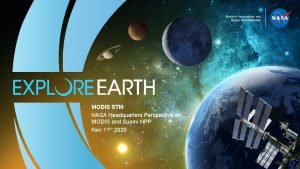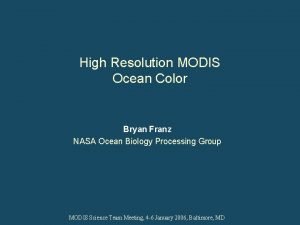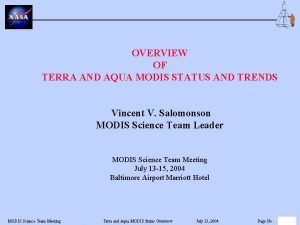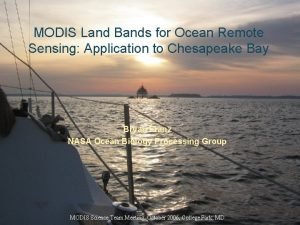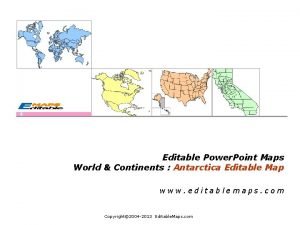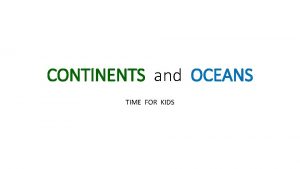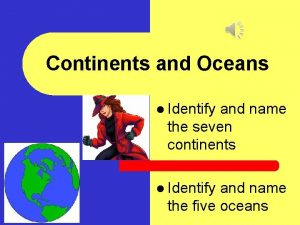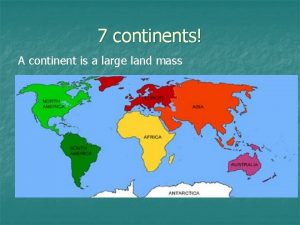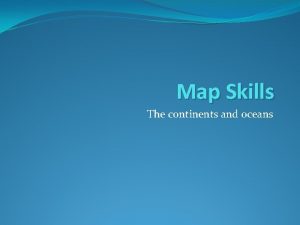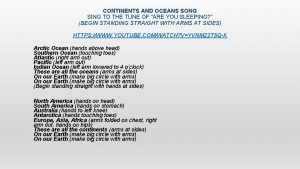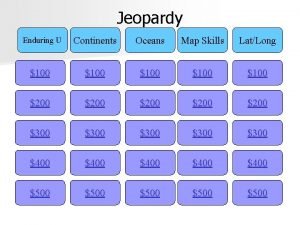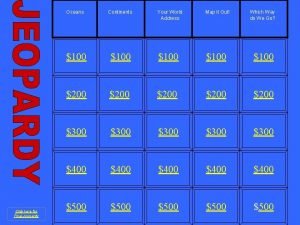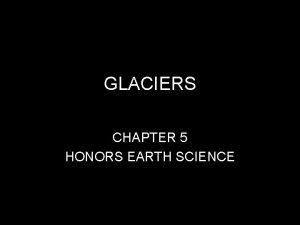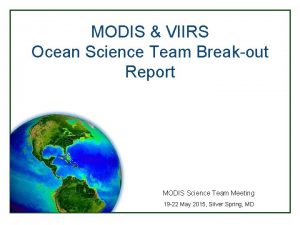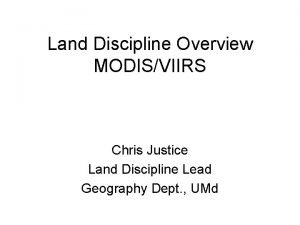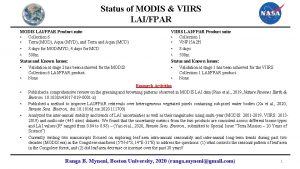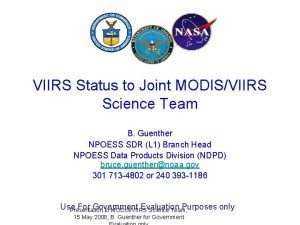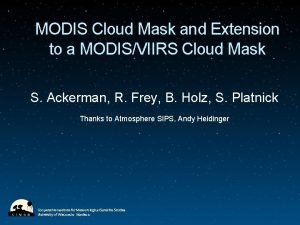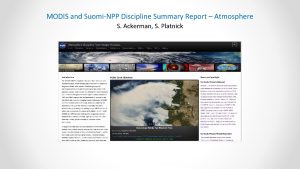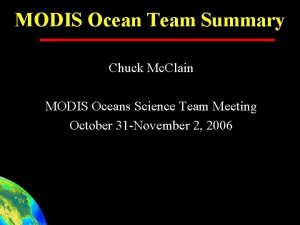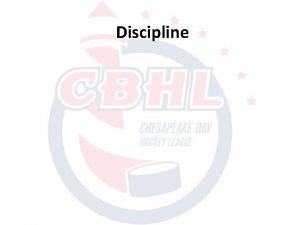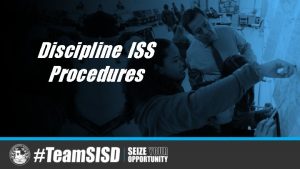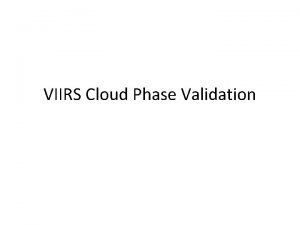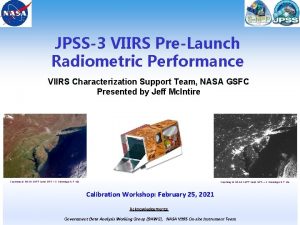MODIS and VIIRS Discipline Summary Report Oceans MODISVIIRS



















- Slides: 19

MODIS and VIIRS Discipline Summary Report - Oceans MODIS/VIIRS Science Team Meeting 18 -21 November 2019, College Park, MD

Ocean Breakout Agenda 1: 30 MODIS/VIIRS Ocean Processing Status and Plans B. Franz 2: 30 Ocean Optics and Biogeochemical Protocols A. Mannino 3: 30 Sea. BASS Data Submission 4: 00 Open Discussion C. Proctor/V. Sanjuan

Update and Expansion of Ocean Optics Protocols Vol. 1. 0 Absorption (particles) COMPLETED Nov. 2018 Particulate Organic Carbon Posted for public comment Vol. 2. 0 Beam-c COMPLETED April 2019 Phytoplankton Taxonomy WG Data Reporting Final writing coming 2020 Vol. 3. 0 Radiometry for Validation Vol. 4. 0 Inline Flow. Through IOPs ~COMPLETED Nov. 2019 Scattering Properties Primary Productivity Writing Stage late 2020 ? Writing Stage 2020 -2021 CDOM Absorption Posted for public comment Noteworthy & Supplemental Topics on Ocean Colour Radiometry Writing Stage 2020 -2021

Discussion on Future Priorities Future Protocols (for consideration) • • • Suspended Particulate Matter (in house lit. review? ) Dissolved Organic Carbon (in house lit. review? ) Phytoplankton community enumeration, identification, biovolume Phytoplankton Carbon HPLC Pigments update Phycobilin Pigments Particle Size Distribution Particulate Inorganic Carbon Fluorescence properties

Ocean Breakout Agenda 1: 30 MODIS/VIIRS Ocean Processing Status and Plans B. Franz 2: 30 Ocean Optics and Biogeochemical Protocols A. Mannino 3: 30 Sea. BASS Data Submission 4: 00 Open Discussion C. Proctor/V. Sanjuan

Standard Products Product POC Rrs(l), AOT, Angstrom Franz Sensor MODIS, VIIRS Chlorophyll a Franz (Werdell, Hu) MODIS, VIIRS Kd(490) Franz (Werdell) MODIS, VIIRS POC Stramski MODIS, VIIRS PIC Balch MODIS, VIIRS* PAR Frouin MODIS, VIIRS n. FLH Westberry MODIS IOPs Werdell MODIS, VIIRS SST (11 um) Minnett (Kilpatrick) MODIS, VIIRS* SST (4 um) Minnett (Kilpatrick) MODIS * orphaned product (no PI selected in current science team) The Ocean SIPS will continue to produce all products, and the OB. DAAC will continue to distribute, regardless of orphan status. Inherent Optical Property (IOP) suite has been in standard production for many years, selected through multiple science team iterations, documented, validated.

SST Reprocessing Status VIIRS/SNPP • MODIS continuity algorithm (PI Minnett, not reselected) • R 2016. 0 (Mid 2016) – first processing of SST for VIIRS, new quality flag based on alternating decision trees, VIIRS-specific algorithm coefficient and error tables. • R 2016. 1 (July 2018) – updated SSES tables, revised ice masking, minor fixes (changes only implemented forward-stream). • R 2016. 2 (in progress) – new reference SST (GHRSST L 4 CMC) MODIS (Aqua and Terra) • R 2019. 0 (pending) – incorporates algorithm changes associated with VIIRS R 2016. x, adds dust correction, updates to algorithm coefficient and error tables Reprocessing of SNPP/VIIRS nearly complete, with algorithms and updates developed in previous Science Team cycle. Reprocessing of MODIS to follow soon, with algorithm refinements. No J 1 VIIRS SST is being produced.

PDSST Implementation Status • Physical Deterministic SST (PDSST) algorithm (PI Koner) • Algorithm description provided • Prototype code and sample products provided • SIPS integration in progress (conversion from MATLAB to C++, incorporation of additional 3 rd-party library dependencies (CRTM), ancillary dependencies) • anticipated to become a provisional product for distribution by OB. DAAC Ocean SIPS is working on implementation of the PDSST algorithm, with expectation of full production and distribution as a Provisional Product. Computationally expensive, but potential for much improved coverage with equal or better validation results.

Ocean Color Reprocessing R 2018. 0 Completed • VIIRS/SNPP (Dec 2017), MODIS/Aqua (Jan 2018), MODIS/Terra (April 2018), and VIIRS/JPSS 1 (Sep 2018) Purpose • incorporate updates to vicarious calibration due to revised MOBY time-series • incorporate updates to instrument calibration • no algorithm changes since R 2014. 0 • first processing for VIIRS on JPSS-1 VIIRS has been fully integrated into the current ocean color processing (R 2018. 0) and OBPG product validation system. Vicarious cal to SNPP, no temporal cal.

VIIRS Spectral Band Centers and Widths Band Center and FWHM (nm) SNPP VIIRS J 1 VIIRS 410 (20) 411 (18) 443 (15) 445 (17) 486 (19) 489 (19) 551 (20) 556 (18) 671 (19) 667 (19) 745 (14) 746 (13) 862 (38) 868 (36) 1238 (26) 1601 (60) 1604 (60) 2257 (46) 2258 (52) Relative Spectral Response of Band 4 JPSS 1 SNPP Wavelength (nm) The two VIIRS instruments are not created equal. Significant differences in spectral bands. note: Rrs is reported at the nominal spectral band centers, based on the measured SRF.

VIIRS Annual Mean Chlorophyll Concentration for 2018 SNPP Aqua Terra MODIS JPSS-1

• VIIRS/SNPP shows negative trend relative to VIIRS/JPSS 1 & MODIS/Aqua VIIRS/JPSS 1 Chl (mg m-3) VIIRS/JPSS 1 & VIIRS/SNPP & MODIS/Aqua VIIRS/SNPP MODIS/Aqua & MODIS/Terra & Sea. Wi. FS Chl (mg m-3) • Sea. Wi. FS, MODIS/Terra, MODIS/Aqua in good agreement, with shortterm deviations Chl (mg m-3) Comparison trends over common mission lifetime Chl (mg m-3) Global Deep-Water Chlorophyll Trends SNPP VIIRS current products showing suspect drift in blue bands (445, 486). Presentation by Eplee on Monday described our efforts to resolve through improved modeling of lunar and solar calibration and corrections for modulated SRF.

VIIRS R 2018. 0 Validation Rrs(445) Rrs(556) • VIIRS/SNPP Rrs and Chlorophyll in very good agreement with in situ JPSS 1 Match-ups to Sea. BASS and AERONET-OC Bias = +0. 0004 sr-1 • VIIRS/JPSS 1 Rrs in good agreement, but with larger differences based on limited match-ups Chlorophyll SNPP VIIRS/SNPP showed significant reduction in bias from R 2014 to R 2018 (not shown) Bias = -0. 0012 sr-1 Bias = +0. 0000 sr-1 Bias = -0. 0007 sr-1 Bias = 4%

MODIS R 2018. 0 Validation Rrs(443) • MODIS Rrs and Chl from Aqua and Terra in good agreement with in situ Bias = +0. 0001 sr-1 Bias = -0. 0005 sr-1 Bias = 18% Bias = -0. 0001 sr-1 Bias = -0. 0006 sr-1 Bias = 9% Terra • Mean bias in Rrs remains near zero MODIS showed significant reduction in bias from R 2014 to R 2018 (not shown) Chlorophyll Aqua Match-ups to Sea. BASS and AERONET-OC Rrs(547)

In situ Rrs Match-up Statistics field data from AERONET-OC and Sea. BASS l (nm) Mean Bias (sr-1) Aqua MAE (sr-1) l (nm) Terra Aqua Terra 412 0. 00001 -0. 00031 0. 00102 0. 00106 410 443 0. 00005 -0. 00014 0. 00077 0. 00079 443 488 -0. 00054 -0. 00053 0. 00079 0. 00078 531 -0. 00055 -0. 00053 0. 00078 0. 00076 547 -0. 00050 -0. 00055 0. 00078 0. 00079 555 -0. 00079 -0. 00080 0. 00094 667 -0. 00018 0. 00029 0. 00030 678 -0. 00016 -0. 00019 0. 00033 0. 00036 Mean Bias (sr-1) JPSS 1 MAE (sr-1) SNPP JPSS 1 SNPP -0. 00072 -0. 00036 0. 00130 0. 00105 0. 00002 0. 00110 0. 00077 486 -0. 00062 -0. 00063 0. 00108 0. 00088 551 -0. 00115 -0. 00071 0. 00150 0. 00088 671 -0. 00034 -0. 00020 0. 00050 0. 00029 0. 00041 • MODIS (Aqua & Terra) and VIIRS/SNPP show very similar agreement with in situ measurements • VIIRS/JPSS 1 shows larger Mean Bias and MAE, based on limited match-ups, with no temporal calibration and no vicarious cal to MOBY

NASA Ocean Color Reprocessing 2020. 0 Planning for Spring 2020, first major update of algorithms since R 2014. 0 1. updates to ancillary data sources - from NCEP/TOMS-OMI/etc. to MERRA-2 assimilation product 2. updates to atmospheric correction methods and tables - multi-scattering aerosol selection, potential use of NIR-SWIR (Ibrahim et al. 2019, Frontiers), improved gas corrections (H 2 O), bug in Rayleigh tables at extreme solar zenith, error propagation 3. updates to pure seawater optical properties (nw, aw, bbw) - apply temperature & salinity dependence (e. g. , Werdell et al. 2013), bug in pure-water aw/bbw (off by few nm) 4. updates to masks and flags - reduced straylight masking (Hu et al. 2019, JGRO), absorbing aerosol flag based on MERRA-2 transport model 5. updates to derived product algorithms CHL algorithm refinements - chlor-a coefficient update (Hu et al. 2019, JGRO; O'Reilly and Werdell, 2019), PIC pic tables, etc. updates, bb* POC algorithm refinement 6. new products - Rrs uncertainties (TBD), new standard products (TBD) PAR uncertainties

Higher Spatial Resolution Level-3 Products • Standard Level-3 products are based on binning from Level-2 native resolution into quasi-equal-area bins at 4. 6 x 4. 6 km, using the center location of the observation. • Users frequently ask for higher resolution binned/mapped data products, or produce them with the standard binner in Sea. DAS. • Result is poor quality imagery and invalid statistics due to pixel growth from nadir to scan edge. • OBPG developed an efficient mechanism to approximate the observational footprint of each pixel and weight the contribution into the fixed geographical bins. • Updated binner will be distributed with Sea. DAS, and may be utilized in next reprocessing to produce higher-resolution standard products.

Questions?

Product Documentation? • The end-user needs a Product User's Guide, and it needs to be up-to-date. • The Ocean SIPS developed the concept of a Product and Algorithm Description Document, PADD), a living document that includes: 1. 2. 3. 4. 5. a brief description of the product and it's purpose a brief description of the algorithm with links to associated publications for more details of implementation differences for each sensor direct links to source code for even more details (live links) product validation results (live links) ESDS has responded with initiation of an on-line tool for development of algorithm documentation, called the NASA Algorithm Publication Tool (APT). https: //docs. google. com/presentation/d/1 i_jw 2 ilr. Fc 0 VPWmb. IHLb. Vf. Y-5 SHue 3 iw. Y 25 h 0 fo 2 VA/edit#slide=id. p The Ocean SIPS has been participating in requirements development and testing.
 Modis competence center
Modis competence center Modis
Modis Lance modis
Lance modis Hdf tools
Hdf tools Stm nasa
Stm nasa Modis
Modis Aqua terra modis
Aqua terra modis 3f443
3f443 Outline map of continents and oceans
Outline map of continents and oceans Map of continents and oceans for kids
Map of continents and oceans for kids The five oceans and seven continents
The five oceans and seven continents The prime meridian runs through which 3 continents
The prime meridian runs through which 3 continents The prime meridian runs through which 3 continents
The prime meridian runs through which 3 continents Continents and oceans map
Continents and oceans map Five oceans song
Five oceans song Continents and oceans jeopardy
Continents and oceans jeopardy Continents and oceans jeopardy
Continents and oceans jeopardy Morraine glacier
Morraine glacier Difference between progress report and status report
Difference between progress report and status report Art as humanistic discipline
Art as humanistic discipline
